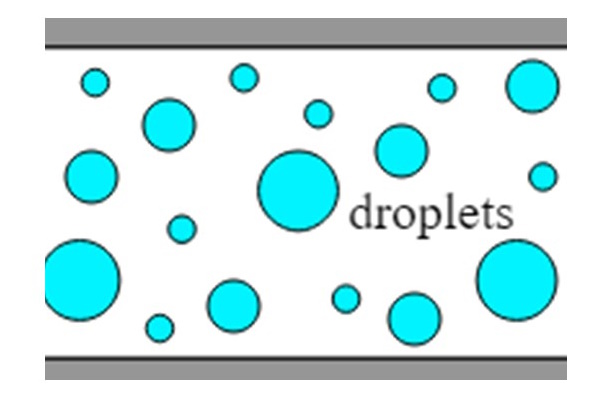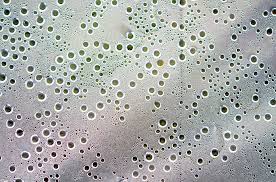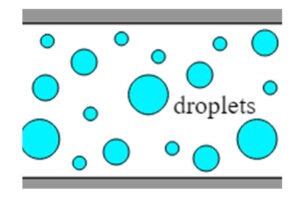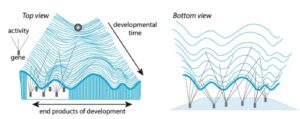Introduction
Membrane-less cellular compartments are characterized by liquid-phaseproperties and are important for sub-cellular organization and function. However, it remains an open question how these cellular compartments are maintained and how they are regulated in response to external cues. Liquid-liquid phase separation (LLPS) is an extended phenomenon regulating cell compartmentalization.

Ultra fast temperature shift device for in vitro experiments under microscopy
Liquid-like cellular compartments in LLPS
Organization of space inside cells is important for cell function. Cellular compartmentalization through organelles separated by a membrane ensures regions of highly specialization of functions inside the cytoplasm, like is the case of mitochondria or lysosomes [1]. Additionally, other cell compartments are delineated without membranes while they retain specialized functions. These compartments are characterized by a liquid-like state and have been defined as biomolecular or cellular condensates [3]. Recent discoveries on liquid-phase membrane-less compartments have allowed for a better understanding of sub-cellular organization and function.
In physics terminology, soft matter defines physical states which are non-solid and are characterized by deformation upon mechanical stress or temperature. Soft matter states include liquids, complex liquids, gels and colloids [2]. In liquid-like states, components contained inside the liquid can easily move and mix. The shape of a liquid is determined by its surface tension [1] (Figure 1).
In biology, the idea of the cell as a colloid or molecular condensate was proposed in the 19th century by Edmund Wilson [3]. Indeed, recent discoveries have shown how multiple cellular compartments are characterized by liquid properties, including high turnover of components and easy deformation. Transport in and out of cellular compartments occurs through fast diffusion while neighbor compartments are maintained separated. The liquid-state properties of membrane-less cell compartments are very suitable for chemical reactions [1]. Some examples of cellular liquid states are:
– the actomyosin cytoskeleton, which can be considered as a gel which will change shape upon deformation.
-Stress granules and P bodies: membrane-less organellesmade of proteins and RNA dedicated to the storage and degradation of RNA. The liquid-like behavior of P granules, which are spherical and remain as a compartment inside the cytoplasm, was initially discovered in the C. elegans embryo.
-The nucleolus: a non-membrane compartment inside the nucleus consisting on RNA and proteins which give rise to ribosomes. While the nucleolus remains a separatecompartment, molecular exchanges with the nucleus are crucial for cellular function, including ribosomal export upon synthesis.
Recent discoveries are pointing at heterochromatin and telomeres as a phase-separated compartments as well and this could have major implications for the understanding of their regulation.

Liquid-liquid phase separation (LLPS) in biology
Inside the cell, different liquid-phase compartments remain separated. Very emergent questions in cell biology are how these liquid compartments are generated, how they remain separated (liquid de-mixing) and how their dynamics are regulated.
Liquid-phase compartments in the nucleus and the cytoplasm remain separated from each other through liquid-liquid phase separation (LLPS). LLPS occurs because of a different molecular composition between compartments, with local concentration of molecules in one compartment keeping it separate it as such.The boundaries between compartments allow for the passage of certain molecules but not others [3]
The local concentration inside a compartment can be generated by spontaneous nucleation of a given molecule. In vitro experiments have shown that there is a minimal concentration upon which a molecule will nucleate and undergo phase separation [3]. For example, nucleation of molecules around a centriole will generate the centrosome [1]. These are some examples of liquid-liquid phase separation occurring inside the cell:
- Multiple binding sites on a protein (multivalency) can induce phase separation by allowing for multiple intermolecular interactions. Large supramolecular complexes generate rapid phase transitions inside the cell, which will be visible in the form of liquid droplets [5].
- Multi-domain proteins (containing non-soluble domains) and IDPs (intrinsically disordered proteins), are promoters of phase separation due to their amino-acid composition and conformational states [3]. Multivalent and multi-domain proteins are frequent in nature and they have been proposed as possible widespread mechanisms for cell compartmentalization.
- RNP (ribonucleoproteins) granules are dynamic and they can switch from liquid to solid phases. The biological role of these phase transitions remains poorly understood. FUS (Fused in Sarcoma) is an RNA binding protein involved in multiple cellular processes, including transcription, splicing and DNA damage response. It can be nuclear or accumulate in liquid-phase stress RNP granules in the cytoplasm. The balance between these two states is important for cellular function and a de-regulation can lead to disease [6](link to our chapeau Rosen). RNP granules phase transitions have been observed as well during the early development of C. elegans, in a developmentally regulated process in which RNP phase transitions respond to developmental cues [7].
- Role of phase separation during the DNA damage response. PAR (poly ADP-ribose) is a family of proteins with a role in the DNA damage response and genome maintenance. PAR-induced local concentration of factors at the DNA damage sites is known to occur through phase separation [3]. PAR acts as a molecular trigger of phase separation through electrostatic interactions and subsequent nucleation of IDPs (intrinsically disordered proteins). This would be an example of a de novo nucleation, with PAR initiating nucleation on a new cellular location (where DNA damage takes place) generating a site-specific compartmentalization [8].
- Phase-separation in stress response. Phase separation is very dependent on environmental conditions. Intracellular changes in pH or temperature drive phase separation phenomena. A possible role of phase separation in stress response and adaptation has been suggested [3].
Liquid-phase cellular compartments are dynamic and LLPS are transient and reversible. Liquid-like cellular compartments can grow, fuse to other compartments (droplet fusion), exchange molecules with neighbor compartments, or turn into more solid states in a droplet maturation process [3]. Cell compartment dynamics and liquid-liquid phase separation are regulated processes. Cells can regulate concentration of proteins (for instance by regulation of transcription or cellular localization). Post-translational modifications are also important for phase separation regulation, for instance by modifications which affect the solubility of proteins.
De-regulation of liquid-liquid phase transitions can lead to disease. Typically, protein aggregation is a hallmark of neurodegenerative diseases. Aberrant aggregation of molecules can generate the loss of theliquid state of a compartment (Alzheimer or Parkinson disease) [1]. De-regulated cytoplasmic FUS aggregates are linked to frontotemporal dementia (FD) and amyotrophic lateral sclerosis (ALS) [9].
At the interphase between physics and biology, the role of LLPS in cell biology has only started to be investigated recently and it is likely new discoveries in the coming years will help to understand multiple molecular events.



